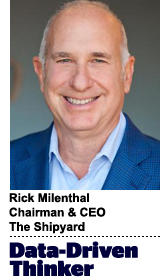 “Data-Driven Thinking” is written by members of the media community and contains fresh ideas on the digital revolution in media.
“Data-Driven Thinking” is written by members of the media community and contains fresh ideas on the digital revolution in media.
Today’s column is written by Rick Milenthal, CEO at The Shipyard.
As companies invest more in the collection and analysis of customer data, the expectation rises that deep customer knowledge alone will drive more efficient and impactful marketing.
It’s a powerful point of view but can also prompt creative leadership to wonder: Will a reliance on data kill creativity?
Meanwhile, the czars of data have their own concerns: Is creativity superficial and the enemy of quantifiable measurable success?
The answer to both is yes.
That’s because an overreliance on either data or creativity is the quickest path to failure. Instead, both must learn to live harmoniously without one being sacrificed for or detracted from the other. Our collective success depends on it.
The most accomplished creative directors have honed their instincts over dozens of years and thousands of executions. It makes perfect sense that they would rather rely on their gut to make critical advertising decisions than on insights derived from machine-learning programs.
However, the best data scientists argue that they too are creative thinkers, that their work is not merely a starting point or foundation of campaign development. They argue that their immensely powerful tools and data science techniques are an integral component of persuasive communications.
Both are correct, of course. That’s why the best marketers must embrace both the power of data to understand the beautiful complexity of millions of people and the power of persuasion, which is achieved only when a story is well told. Both must cohabitate to be truly integrated into any marketing strategy.
But how?
Critical questions
At an operational level, the blending of data and creativity requires a consistent and constant approach to cross-pollinating ideas and an openness by both sides to try anything. I believe every initiative should begin with a gathering of data scientists, media planners and creative talent to facilitate an open and honest dialogue. It’s a simple exercise that can spark magic as creatives express their curiosity about audiences and data analysts propose new ideas.
This approach often triggers new ways to develop messaging and value propositions that line up against potential audience segments. Employing visual storytelling to explore more possibilities and potential solutions, teams should be asked simple but powerful questions: What sorts of variables can be introduced to learn something about an audience segment?
Should the products be shown grouped or singularly? What would happen if the set were changed to a room in which the target audience could see themselves?
Creative experimentation
Another method to consider is creative experimentation, which leverages artificial intelligence, machine learning and social listening tools to identify all possible audiences that – when paired with the right messages – are the mostly receptive to increased awareness, trial and conversion.
Creative experimentation allows marketers to test hundreds of concepts and lean into the most effective ideas. When every idea can be tested in the marketplace with millions of impressions before serious investment is made, then all great ideas can be on the table. Even better, it can be done with little media spend, thus affording teams a chance to experiment before making bigger and more confident bets.
The end effect is an even braver marketing strategy, providing essential fuel for creatives to experiment and for analysts to create a more dimensionalized view of how customers perceive a brand. Creative experimentation can provide deeper predictive insights into the stimuli that influence purchase behavior.
In the end, marketing bravery cannot be achieved by data or creative alone. Only by working and living together in harmony can data geeks and storytellers create, test and succeed with unlimited new ideas.
So, get started. Cohabitate.
Follow The Shipyard (@TheShipyardCrew) and AdExchanger (@adexchanger) on Twitter.
This post was syndicated from Ad Exchanger.


More Stories
Daylight welcomes new Art Director
Here’s How to Watch Donald Trump’s State of the Union Address
Shortlist announced for 2025 IHAC Awards